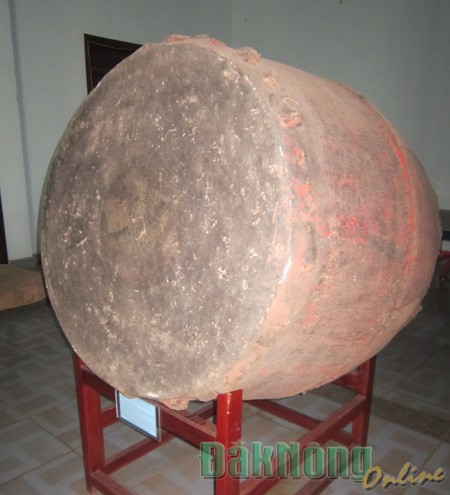
Choes (big-bellied jar), gongs, and drums… are familiar objects of M’nong people, of which, Trong Cai (a large drum) is considered as a sacred object that bring peace and health for its owner.
Trong Cai of M'nong people is created through a lot of painstaking and complicated stages and the maker must strictly obey a set of rules, customs and deity rites.
 |
| Trong Cai (large drum) of M'nong people |
Trong Cai of M'nong people is made of whole-trunk timber while using the technique of carving and piercing. M'nong people use the tools such as axe, knife… to carve and pierce the body of the drum from the two sides inwards. After that, the axe and the knife are used to adjust and carve untill the two sides communicate with each other.
After piercing the body of the drum, the maker would not bring it home right away but leave it in the forest for about 25 to 30 days until it get dried up. Then, the maker gets back to the forest, worships and makes offerings before bringing the drum home. The offering is either a male buffalo if the maker is rich or a pig if the maker is poor.
According to the conception of M'nong people, all objects has supernatural power. They reckon that objects exist with the parallel interaction of Yin and Yang and in the harmony of universe… therefore, in making the surface they use the leather of both male and female buffaloes. When slaughtering a buffalo, people slightly remove the leather to avoid tearing it, then remove all the meat stuck to the leather, dip it in lime water, and leave it out to the sun until it gets an expected leathery threshold. When covering the drum surfaces, the leather must be spun and stretched very tight over the surface; then the pins made of bamboo would be used to fix the leather so that it doesn't get loose over use.
Regarding using Trong Cai in festival, if one surface of the Trong Cai is previously covered by the leather of a male buffalo, then in the next festival, people would slaughter a female buffalo to get the leather for covering the other surface of the drum. The person who is chosen to do the job of covering the drum surface must be someone who knows how to drum, has a lot of experience, deep understanding of culture, health and prestige in the family, and the village.
When the drum surfaces are completed, the owner holds an offering ceremony to invite deities over. People take blood of the animals to offer sacrifice and rub it over the surfaces of the drum twice (the sacrificed animal is usually a pig weighing from 30 to 40 kilos. At first, the blood of the animal is used to make a circle shape at the middle of the drum surfaces. Next, the blood is rubbed over the two surfaces of the drum. In this way, it is belived that the deities would take the place and bless or support the family so that the people in the family would be healthy and their descendants would do well in their study.
One surface of Trong Cai of M'nong people are defined as male and the other surface as female. The male and the female surface are told apart based on their design (male surface has a well-aired hole while the female one doesn't) and base on the sound made when beating the surface (the male surface makes low and strong sound; the female one makes elegant and high sound)
For M'nong people, Trong Cai can be used to tell if the villages, families or the households are wealthy or not. The wealthy villages would have from 4 to 5 drums; wealthy the families or households have 1 drum while poor villages have from 1 to 2 drums.
M'nong people use Trong Cai to inform or give the signal of big festivals of the village or an important event of the households, families and it is used in funerals. Especially, Trong Cai is never arranged as a component of the gongs ritual.
Trong Cai is a sacred object of the village, family and household so it is always carefully kept in solemn places. Normally, Trong Cai is either given to people having prestige and position in the family or the village patriarch (if the drum belongs to the village) to keep and save.
According to baodaknong.org.vn